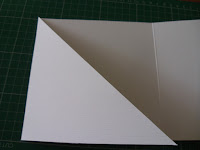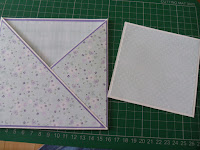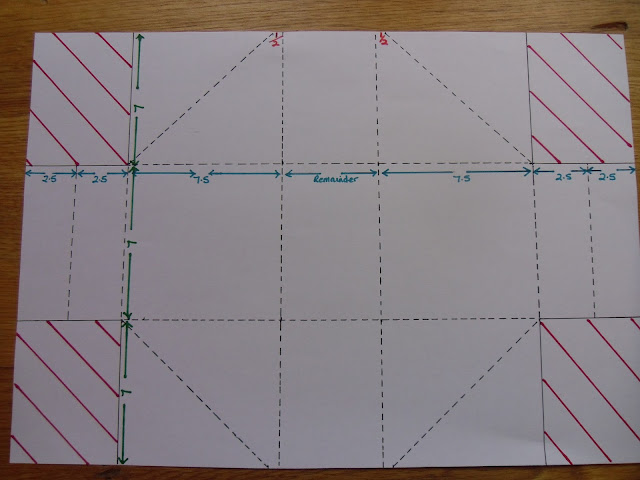

 I began with a piece of card A4 length x just under 15 cms (or 12" x 6"), and a second piece Just under 15 cms square (or a 6" sq). The larger piece needs to be scored to make a gatefold card. The smaller pieces need to be cut into two, diagonally.
I began with a piece of card A4 length x just under 15 cms (or 12" x 6"), and a second piece Just under 15 cms square (or a 6" sq). The larger piece needs to be scored to make a gatefold card. The smaller pieces need to be cut into two, diagonally.


 Attach the two triangular pieces to the front 'gates', and trim. ***Keep the waste***
You should have something that looks like this.
Attach the two triangular pieces to the front 'gates', and trim. ***Keep the waste***
You should have something that looks like this.

 Next I created some mats. You will need two squares of 5 3/4" (mine are purple) and two squares of 5 1/2" (mine are a check and a floral pattern). The inside square mat is pretty straight forward. Before you stick your diagonal mats, match up at the right angle point and reduce along the long diagonal edge, so that you have an even border all the way round.
It doesn't matter which way you overlap your diagonal gates, but you need to secure your first side at the bottom, so that whatever you put in the pocket, doesn't fall out.
Next I created some mats. You will need two squares of 5 3/4" (mine are purple) and two squares of 5 1/2" (mine are a check and a floral pattern). The inside square mat is pretty straight forward. Before you stick your diagonal mats, match up at the right angle point and reduce along the long diagonal edge, so that you have an even border all the way round.
It doesn't matter which way you overlap your diagonal gates, but you need to secure your first side at the bottom, so that whatever you put in the pocket, doesn't fall out.

 Attach one of your diagonal mats, then overlap the second gate, sealing at the bottom part only (see photo on left)
Attach one of your diagonal mats, then overlap the second gate, sealing at the bottom part only (see photo on left)
 Attach the second diagonal mat, and you should have something that looks like this.
Now to be able to stand it up, you need to create a support for the back. Remember the 'waste' when you trimmed the gates earlier ? - score approximately at 1cm (3/8"), and trim a diagonal off the bottom, as shown in the picture below. If you trim a deeper diagonal, the card will tilt more - this is personal preference, but I would suggest you don't overdo it, as you can always take a little more off if required.
Attach by the scored strip. These are the side and back views.
Attach the second diagonal mat, and you should have something that looks like this.
Now to be able to stand it up, you need to create a support for the back. Remember the 'waste' when you trimmed the gates earlier ? - score approximately at 1cm (3/8"), and trim a diagonal off the bottom, as shown in the picture below. If you trim a deeper diagonal, the card will tilt more - this is personal preference, but I would suggest you don't overdo it, as you can always take a little more off if required.
Attach by the scored strip. These are the side and back views.
 I made a card for the inside 11 cms square (4 3/8") with mats cut to 4 1/8" & 3 7/8" squares. The smaller one I made using the same base white card, as I intended stamping a verse on it.
I made a card for the inside 11 cms square (4 3/8") with mats cut to 4 1/8" & 3 7/8" squares. The smaller one I made using the same base white card, as I intended stamping a verse on it.
 For the tab top, I made this by folding some of the purple paper and punching the majority of a circle, so the straight edge towards the top was at the fold. If using card, you will have to make two matching tabs, otherwise you might ruin your paper punch. I then used my cutting mat to mark where I was going to remove. Mine lined up nicely with the 1cm marks, but you can adjust, depending on the size of your circle. I used the circle punch to remove these sections, lining up with the pencil marks.
I attached it to my insert, which I stamped with a verse, and also some pale inked flowers, as not to detract from the verse, just to add a subtle background and remove some of the starkness.
With the addition of a Magnolia figure, coloured in water colour pencils, and blended with a damp brush......Et voila !!
Enjoy,
Christine
For the tab top, I made this by folding some of the purple paper and punching the majority of a circle, so the straight edge towards the top was at the fold. If using card, you will have to make two matching tabs, otherwise you might ruin your paper punch. I then used my cutting mat to mark where I was going to remove. Mine lined up nicely with the 1cm marks, but you can adjust, depending on the size of your circle. I used the circle punch to remove these sections, lining up with the pencil marks.
I attached it to my insert, which I stamped with a verse, and also some pale inked flowers, as not to detract from the verse, just to add a subtle background and remove some of the starkness.
With the addition of a Magnolia figure, coloured in water colour pencils, and blended with a damp brush......Et voila !!
Enjoy,
Christine
Another quick and easy card for you this week....you can tell who's busy can't you !!!!
Begin by scoring a piece of card in half. Now bearing in mind that this score line will need to fall in a diagonal position, it is best turning the card until you think it is where it needs to be....try and visualise the finished card. Then draw a line in the other diagonal direction, from what will be the top point, that looks as if it is flowing at a similar angle. This is your cutting line. When you have cut something that resembles a triangle at the top, use a plate or something similar to draw a cutting line for the bottom 'rocker' scoop.
 As you can see in the picture on the left, the card only sits on a small part of the lower edge - that which is most prominent - this allows it to rock from side to side. You will notice that I have put the sentiment on a mat at the top. Partly because I wanted to add a sentiment, but more importantly, adding a little weight at the top (evenly spread over the centre so that it is balanced) which enables the rocking to retain momentum for a while before you have to set it going again.
The photo on the left shows a close up of the lower scoop.
I decorated my card simply, using the shape of the base card to graduate down for my mats, first in mulberry paper (wet and torn for a wispy edge) then a piece of patterned paper. I finished with a Magnolia girl, stamped, coloured and cut out and slightly domed and attached with silicone glue to give a little dimension.
At at the top, I punched 2 holes to thread a piece of ribbon through, tied in a bow, cured the ribbon around some scissors, and added some punched card flowers, fixed back to back on the ends of the ribbon to weight it to hang down.
Have fun....sorry I must dash
Christine
As you can see in the picture on the left, the card only sits on a small part of the lower edge - that which is most prominent - this allows it to rock from side to side. You will notice that I have put the sentiment on a mat at the top. Partly because I wanted to add a sentiment, but more importantly, adding a little weight at the top (evenly spread over the centre so that it is balanced) which enables the rocking to retain momentum for a while before you have to set it going again.
The photo on the left shows a close up of the lower scoop.
I decorated my card simply, using the shape of the base card to graduate down for my mats, first in mulberry paper (wet and torn for a wispy edge) then a piece of patterned paper. I finished with a Magnolia girl, stamped, coloured and cut out and slightly domed and attached with silicone glue to give a little dimension.
At at the top, I punched 2 holes to thread a piece of ribbon through, tied in a bow, cured the ribbon around some scissors, and added some punched card flowers, fixed back to back on the ends of the ribbon to weight it to hang down.
Have fun....sorry I must dash
Christine
This is a great little gift than everyone will be able to make. It isn't complicated. Simply follow the instructions and pass it on to someone with love.
It can be made from the size of an A4 piece of paper. It does look better if you use a double sided paper, but there is nothing to stop you sticking 2 thinner, single sided sheets together. A4 size is 21 cms wide by approximately 29.8 cms
The red diagonal lines in the four corner areas will need to be removed after you have scored all lines indicated by a dashed line, and cut on the solid lines.
So in the landscape position, score 2.5 cms; 2.5 cms; 7.5 cms......and repeat from the other end so that the 'odd amount leftover' will become the base.
 In the portrait position score at 7 cms; and 7 cms, so you have 3 equal sections.
In the portrait position score at 7 cms; and 7 cms, so you have 3 equal sections.
When you score the diagonal lines (this is the landscape view), on the 7.5 cms width, start your score 1/2 cms within the score line.
After you have removed those 4 corner sections, fold in the 4 diagonals.
Flip over and turn back the outer 2.5 cms sections.
 Flip back and fold in the left third.....
......then fold in the right third.
Keeping these folds on the outside, pull one end around to meet the other, and faster with a clip or peg.
Grab your tea bag, and if you wish, you could type or write a little rhyme and cut out in a shape of your choice.
Put the tea bag in one pocket and the rhyme in the other.....then pass it on with love to someone you feel may need a lift and a smile.
Christine
Flip back and fold in the left third.....
......then fold in the right third.
Keeping these folds on the outside, pull one end around to meet the other, and faster with a clip or peg.
Grab your tea bag, and if you wish, you could type or write a little rhyme and cut out in a shape of your choice.
Put the tea bag in one pocket and the rhyme in the other.....then pass it on with love to someone you feel may need a lift and a smile.
Christine
You will need:
Acetate
Black Stayzon ink
Johnsons Klear floor polish
Tissue paper (white)
Acrylic paints
Rubber stamps
Paintbrush
Hairdryer
Scissors
Ink up your stamp/s and stamp onto the acetate, pressing firmly all over to get a good impression....but be careful the stamp doesn't slide **always keep one hand on the stamp. Let dry naturally.
On the reverse of the acetate, pour a puddle of the Johnsons Klear, taking care it doesn't run off the edges. Add your chosen acrylic colours, starting with the lightest colour, and gently swirling into the polish.
Crumple up the tissue paper, then loosely open it out and place onto the polish/paint mix. Dab gently with a brush to make sure the tissue has good contact with the fluid and the acetate. You are aiming for plenty of wrinkles, but being careful not to move the paints too much more, otherwise they will all merge into one blended colour and you will lose the overall effect. If you look at mine, you can still see clear yellow and green areas, as well as where it is a mix of the two.
At this stage, you can speed up the drying process, but only with a hairdryer, as a heat tool would melt the acetate and acrylics. Plus, the polish could be flammable. When it is thoroughly dry, it just needs trimming and mounting. Voila :)
Christine



 I began with a piece of card A4 length x just under 15 cms (or 12" x 6"), and a second piece Just under 15 cms square (or a 6" sq). The larger piece needs to be scored to make a gatefold card. The smaller pieces need to be cut into two, diagonally.
I began with a piece of card A4 length x just under 15 cms (or 12" x 6"), and a second piece Just under 15 cms square (or a 6" sq). The larger piece needs to be scored to make a gatefold card. The smaller pieces need to be cut into two, diagonally.



 Next I created some mats. You will need two squares of 5 3/4" (mine are purple) and two squares of 5 1/2" (mine are a check and a floral pattern). The inside square mat is pretty straight forward. Before you stick your diagonal mats, match up at the right angle point and reduce along the long diagonal edge, so that you have an even border all the way round.
Next I created some mats. You will need two squares of 5 3/4" (mine are purple) and two squares of 5 1/2" (mine are a check and a floral pattern). The inside square mat is pretty straight forward. Before you stick your diagonal mats, match up at the right angle point and reduce along the long diagonal edge, so that you have an even border all the way round.



 For the tab top, I made this by folding some of the purple paper and punching the majority of a circle, so the straight edge towards the top was at the fold. If using card, you will have to make two matching tabs, otherwise you might ruin your paper punch. I then used my cutting mat to mark where I was going to remove. Mine lined up nicely with the 1cm marks, but you can adjust, depending on the size of your circle. I used the circle punch to remove these sections, lining up with the pencil marks.
For the tab top, I made this by folding some of the purple paper and punching the majority of a circle, so the straight edge towards the top was at the fold. If using card, you will have to make two matching tabs, otherwise you might ruin your paper punch. I then used my cutting mat to mark where I was going to remove. Mine lined up nicely with the 1cm marks, but you can adjust, depending on the size of your circle. I used the circle punch to remove these sections, lining up with the pencil marks.























